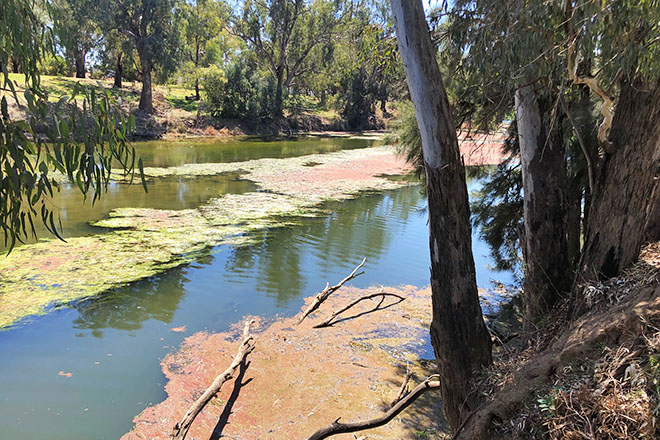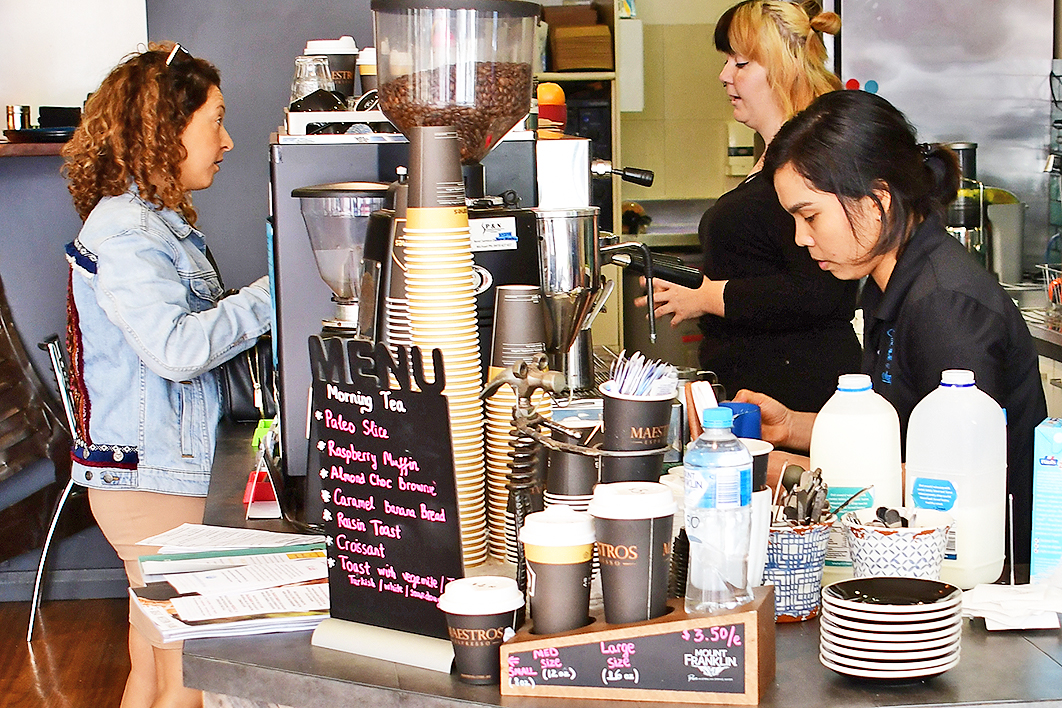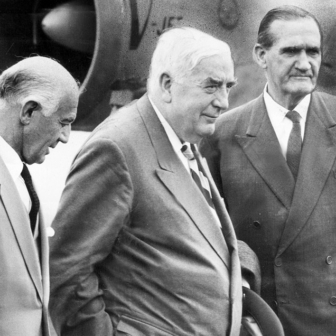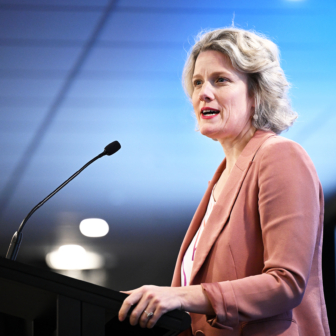It’s Saturday morning in Dubbo, about 400 kilometres northwest of Sydney. The sky is grey: not from rainclouds but from a dust storm whipping topsoil off distant properties devastated by drought. The Macquarie River, which runs through town and feeds into the Murray–Darling system, is covered in green sludge and has long stopped flowing. The outlook should be bleak, and yet Dubbo is booming.
Locals pour in to the Def Chef in the city’s main thoroughfare, Macquarie Street. Cong Phap Bui and Tuyen Tran bought the cafe last year. The couple arrived from their native Vietnam to study in Sydney six years ago. When their student visas expired they wanted to stay in Australia, which would be possible if they worked in a rural area for at least two years. A migration body covering Orana, the region that embraces Dubbo and about a quarter of outback New South Wales, sponsored them.
Phap recalls their first impression of Dubbo. “It was very quiet, very sunny and very hot,” he says. “There were not many people walking in the street.” Three years later, it’s a different scene. Neither Phap nor Tuyen had run a business before they went to Dubbo. They now work seven days a week, starting at 6.30am. When I managed to get a breakfast table, I noticed they have two young local women on their waiting staff; they also employ two chefs. And last June, eight months after they bought the business, they received permanent residency in Australia. “We thought of returning to Sydney, but it’s very crowded there,” says Phap. “Dubbo is very friendly, and isn’t quiet anymore!”
Stories like this are also unfolding elsewhere in town. Two more Vietnamese cafes do brisk business further along Macquarie Street. Around the corner in Talbragar Street, the Tanoshi Japanese restaurant sits opposite the Great Wall, an Asian supermarket that opened in July. Eateries in surrounding streets have created a competitive cafe culture that Dubbo locals could once only have dreamed of.
Macquarie Street looks prosperous and handsome: at one end is the 1887 post office designed by colonial architect James Barnet; at the other is the two-storey Old Bank building, now a bar crowded each night with young professionals. Between them sits the statue Dubbo unveiled last May of William Ferguson, a pioneering Aboriginal rights activist from the 1930s.
In the middle of one of Australia’s worst droughts, Dubbo projects a sense of progressive confidence. It started as a trading post in 1849 on the state’s vast western plains, when sheep, cattle and white settlers were moving in. (The Macquarie Inn, its first hotel, was licensed the same year.) Many settlements further west have since faded or become ghost towns.
Former local radio host Dugald Saunders, the Nationals MP for the state seat of Dubbo, calls the city the “capital of the west.” He estimates that about sixty multicultural groups rub along there. Ben Shields, Dubbo’s mayor, has overseen four citizenship ceremonies so far this year, admitting 134 new Australian citizens; the most recent one, in September, included people from Asia, Africa, the Middle East and Europe.
At 2 per cent, Dubbo’s unemployment rate is less than half that of the state as a whole, and not much over a third of Australia’s 5.3 per cent. Its population of 43,000 people, about 14 per cent identifying as Aboriginal, is growing at a rate of 1.4 per cent a year, a feat matched by few other country areas. Australia’s overall population growth rate of 1.6 per cent, higher than average for rich countries, is driven mainly by people pouring in to the big state capital cities.
Peter McDonald, a demographer at the University of Melbourne, calculates that Dubbo and Albury-Wodonga are the two fastest-growing inland country towns in Australia; their combined populations are rising by 2000 people a year (compared with 2000 a week for Melbourne, the fastest-growing capital).
Governments have talked for decades about decentralising Australia’s population away from the big seaboard cities. Dubbo has become a showcase of how it’s finally working. Duplicating its success elsewhere, though, will be a challenge.
I first visited the Dubbo region as a student from Sydney with a summer holiday job, driving a truck laden with freshly harvested wheat to a railway silo at Geurie, a hamlet about twenty-five kilometres east of Dubbo. Back then, people talked pretty much only about two subjects: wheat and wool. Several decades later, the change is striking.
Although this year’s harvesting season is approaching, the paddocks around Dubbo won’t be yielding any grain. The ground has been too dry for farmers to grow anything. Burrendong Dam on the Macquarie River, a primary source of irrigation and town water, is just 3.7 per cent full. Plans are afoot to access water caught in the dam’s outlet valve, but this fallback step offers only an extra four months’ supply. With their river allocations stopped, farmers are competing with townsfolk for access to artesian water; but without rainfall groundwater, too, is not being replenished.

Sign of change: a stagnant Macquarie River at Dubbo. Robert Milliken
Even in normal times, agriculture had slowly ceded its economic dominance to other industries, as Dubbo grew inexorably into a service town for places like Geurie and Wellington in the east and others as far away as Bourke, about 370 kilometres west.
“No single business or industry is the mainstay now,” says Matt Wright, president of the Dubbo Chamber of Commerce. Wright runs Money Quest Dubbo, a mortgage and finance broking company. Real estate is among Dubbo’s top three industries by value. Houses in town trade for a median price of about $360,000. “Dubbo is a very competitive place to live,” says Wright. But the biggest employers are health services, retail and construction, in that order.
Geoff Wise, a former NSW western lands commissioner long involved in Dubbo’s community affairs, identifies three places whose growing service roles have helped to boost Dubbo’s economy: its stock saleyard, one of the biggest in Australia (where more sheep and cattle are now being shipped out than shipped in); its hospital; and its airport. The last place is undergoing a remarkable transformation.
Dubbo’s location at the crossroads of the Mitchell Highway to Sydney, the Golden Highway to Newcastle and the Newell Highway to Queensland had long made it a road transport hub. Sydney once offered the only direct air link to a capital city. Now, you can fly with various airlines directly to Melbourne, Canberra, Brisbane and Newcastle as well. The airport’s passenger numbers have more than doubled in the past fifteen years. They are just one part of the airport’s boom.
I met Wright in a sprawling new cafe attached to the airport’s latest addition, the Royal Flying Doctor Service Visitor Experience. This new walk-through exhibition looks likely to rival the Taronga Western Plains Zoo at Dubbo as a major tourist drawcard. In another part of the airport’s grounds, construction was under way on the second stage of a new training base for the NSW Rural Fire Service; the first stage, bringing in volunteer firefighters from across the state, opened in July. A new flying doctor training centre has also opened at the airport. And work is due to start next year, elsewhere in Dubbo, on yet another project: a maintenance centre for a new fleet of rural and interstate passenger trains that eventually will replace the state’s entire XPT train fleet.
Dubbo hospital is growing with state and federal funds, and a new cancer treatment centre is on the way. The University of Sydney is expanding the Dubbo campus of a rural health school it runs jointly in Dubbo and Orange; part of the university’s Sydney Medical School, it is designed to train doctors in the challenges of health in rural areas. School manager Kim O’Connor says these challenges grow ever greater: “Drought, climate change, mental health and their impact on rural people are all a big worry. We need to train young people for this instead of losing them to the cities.” She hopes the new graduate program will attract local students, including Aboriginal people, but expects them to come from all over Australia.
A synergy is emerging between all these big projects. Doctors from the flying doctors’ new training centre sometimes teach at the rural health school. “Students interested in emergency medicine love it,” O’Connor says. All this opens the sort of problem that many rural communities would like to have. With low unemployment and construction projects estimated at $5 billion due over the next five years, Matt Wright worries that “there won’t be enough workers to fill the jobs.”
Earlier this year, Canberra launched the latest bid to encourage people to move to places like Dubbo. The Morrison government is offering 25,000 extra visas that will give immigrants permanent residency in Australia if they work for three years in a regional area. It has also signed Designated Area Migration Agreements, or DAMAs, with seven regions around Australia, allowing employers to sponsor skilled and semiskilled workers from overseas if they can’t find them locally.
The Orana region of the state, in which Dubbo lies, is one DAMA. Mechanics and welders, at least, will soon be in big demand there. As well as Dubbo’s planned XPT train service hub, route construction on the proposed Inland Rail freight line between Melbourne and Brisbane will happen around the small town of Narromine, about forty-five kilometres west of Dubbo.
On top of all this, a federal parliamentary committee is about to start an inquiry into strategies for encouraging migrants to settle and stay in regional areas. It’s expected to report in late 2020.
About four-fifths of Australia’s population growth, much of it driven by immigration, is happening in the three biggest cities, Sydney, Melbourne and Brisbane, and their satellite centres like Newcastle, Geelong and the Gold Coast. The Morrison government has cut immigration by 30,000 arrivals to 160,000 next year, partly as a political response to complaints about overcrowding and inadequate transport. Its bid to steer more migrants to the regions could be another string to that political strategy. At first sight, it looks plausible. One estimate suggests over four million jobs will open across Australia by 2024, about half due to the baby boomer generation’s retirement. Mark Coulton, a federal National Party MP whose electorate embraces the Orana region, says “thousands of jobs have been identified” there alone over the next decade.
But some question if a political strategy of steering more people into regional cities can work. In a paper written last year for the University of Melbourne, the demographer Peter McDonald argues that the global economy is moving towards megacities. Australia, he suggests, will be no exception: “There should not be an expectation that future growth of the Australian population… can be redirected in anything other than a minor way to regional Australia.” Cutting immigration to give the big cities breathing space, says McDonald, is “flawed logic,” a sentiment with which former senior immigration official Abul Rizvi agrees. Those cities will always have a bigger variety of jobs and greater demand for workers. If immigration can’t supply them, the big cities will draw them from other parts of Australia, meaning places like Dubbo will lose people, not gain them.
McDonald tells me that Dubbo and similar country towns are attracting young families as new residents, drawn by their promise, prosperity and affordable housing. For immigrants, though, the big test will be whether they stay after fulfilling pathways to permanent residency; “strong evidence,” he says, suggests that many then relocate to big cities. McDonald questions the government’s policy of promising extra points to immigrants if they go to a region. The approach would be more effective, he argues, if local employers had a bigger say in selecting immigrants and matching them to their regions’ specific demands.
In some Dubbo businesses, that is happening already. At least two have also managed to adapt the old mainstay, agriculture, to changing consumer tastes in the outside world.
Roger Fletcher has the classic weathered look and direct approach of an Australian whose life has been shaped by the bush. Born in Glen Innes in northern New South Wales, he started droving sheep as a teenager. His schoolteachers had a low opinion of his prospects: “They told me I might as well leave school at fifteen,” says Fletcher. “So I did. It made me a millionaire.”
Fletcher now presides over Fletcher International Exports, known as Fletchers, a family company on Dubbo’s northern edge. His wife Gail and three children are also involved in the business. Since the Dubbo plant opened almost thirty years ago, they have started a second one at Albany in Western Australia — “to help alleviate climatic risk,” says Fletcher. The company now exports lamb and sheep meat, skins, wool and grains to eighty countries. Five years ago, it started running its own freight trains from the Dubbo plant to the Port Botany export terminal in Sydney, keeping control over goods until they leave the country.

Plenty to think about: exporter Roger Fletcher.
With about 700 workers, Fletchers is Dubbo’s biggest private employer (there are 500 more staff in Western Australia). Drought has slightly dented the Dubbo workforce’s size but not its enthusiasm, or Roger Fletcher’s keenness to hire people from any background who can do the work. He also runs a training program for Aboriginal workers.
Fletcher can’t say what proportion of his staff are immigrants. “Like water, they’ll find their own tracks here. We don’t go out to recruit visa people. They just come. They’re from about thirty nationalities in Asia, Europe and the Middle East. They have all sorts of visas, including those for skilled workers. Some have bought houses and live here. One of the greatest achievements out of this is that no one group of people is above the other. It’s the best workforce I’ve ever had. And it’s happened over the past ten to fifteen years.”
What made him choose Dubbo to build his plant? “It’s the central point for sheep in eastern Australia,” says Fletcher. “A selling centre, a logical location.” Dubbo also owes its growth to the smaller towns it now services. “It wouldn’t be where it is without the back country,” says Fletcher. “It’s vitally important that we look after those towns north, south and west.”
Asked what sort of impact his business has had on Dubbo’s economy over the past thirty years, Fletcher lets out a sigh and says, “I don’t have time to think about that.” He has plenty else to think about. Fletchers’s sheep meat is slaughtered according to Halal practice and Islamic rites. Foreign customers visit the plant every day of the year. On the grain side, he worries that the drought means he has “broken the chain” with customers in Asia. “But out of all bad comes good,” Fletcher says. “Out of this drought, good things will come.”
Just beyond the white, timber Rawsonville Bridge, built over the Macquarie River west of Dubbo in 1916, Emma and Jim Elliott are at work on their farm, the Little Big Dairy. Emma’s family, the Chesworths, started the business after they moved there from the Hunter Valley fifteen years ago. Dubbo, hot, dry and drought-prone, is hardly conventional dairy country, but the family took a risk mainly for environmental reasons, says Emma: the Hunter’s coalmines were affecting its groundwater; Dubbo has more secure groundwater supplies; and Dubbo’s lower humidity and flatter landscape make life easier for cows.
The Little Big Dairy has created what might be called “niche milk.” Emma’s parents and her brother have built a herd of about 1000 Holstein cattle for milking on the farm and export as breeders. Emma and Jim market and distribute the milk in big, colourful trucks that go as far as Sydney, Canberra and Lightning Ridge. In Dubbo, they sell to supermarkets, butchers, fruit shops and cafes, including Def Chef.
Their key selling point is to call their milk “single source”: a claim that every litre can be traced to the cow it came from. High-end cafes are playing up the provenance of their milk now, “as they’ve been doing with coffee beans,” says Emma. “That’s why we’ve kept control of the distribution as well, instead of sending milk out to faceless processors.” Like Fletcher, they employ many working-visa immigrants, mainly French in their case. “They just arrive and ask for jobs,” says Emma. “It makes it easier for us because it’s hard to find local people to do farm work.”
The drought has hit them, too. Locally grown grains are no longer available to feed their cattle; they can irrigate sparingly from groundwater, but not from the Macquarie. But they think their business has contributed to Dubbo’s “high-end cafe culture,” helping to change the town’s image along the way. “People are more connected and understanding of our community than before,” says Jim, who grew up in Dubbo. “They get what we’re doing. We don’t have to explain it.”
On my last morning in Dubbo I meet Rio Paul, who works for the Dubbo Regional Council at its visitor information centre. After Rio and her husband Jerose Joseph emigrated from India, Jerose trained in Melbourne as a hospital worker. He now works as a manager at the Dubbo Base Hospital, and took Australian citizenship last year.
Both came from big cities in India, and wanted to steer clear of them in Australia. At first, Dubbo seemed a challenge for Rio. “I’d never lived in a country town and had no friends or job here,” she says. But she landed a position with a real estate firm “within minutes” of arriving. “It wasn’t as hard as I thought.” Since they arrived, Dubbo’s Indian community has grown. Many work in health services, others at Fletchers. Rio and Jerose plan to stay. They’ve bought a house, and their first child is due. “For the future generation, there are many opportunities here,” says Rio. “We’ve invested in Dubbo.”
Later that day, I set out on the six-hour journey to Sydney on one of the XPT passenger trains due to be replaced by a new model, for which Dubbo will be the service base. The train is crowded, the service efficient. A few minutes after leaving Dubbo we pass through Wongarbon, a hamlet of fine old buildings and about 700 people.
Three days earlier, I had driven there from Dubbo to meet Brett Garling, a noted sculptor and artist whose gallery was once Wongarbon’s general store. Garling sculpted the statue of William Ferguson in Dubbo’s main street, and is now working on a sculpture series to commemorate the horses that once worked in Hunter Valley coalmines.
Garling went to Dubbo High School, but he’s in no hurry to move to what has become a regional boom town. “It’s more like a city,” he says. “Now you can walk down the street and not say hello to anyone you know.” Wongarbon’s smallness, serenity and seclusion suit him fine. He shops mainly in Wellington, a once-prosperous town further east that has struggled as Dubbo has flourished. “To support Wellington,” he explains.
Perhaps it’s Garling’s life as a landscape artist that makes him challenge those who reckon Dubbo’s expansion has few limits, that its growth has really only just begun. Mayor Ben Shields, for instance, enthuses about a proposal last January from the tech billionaire Elon Musk to build a road tunnel under the Blue Mountains for $1 billion, cutting travel time west from Sydney. “That would open Dubbo up even more,” says Shields.
“I don’t agree with the forecast of 100,000 people for Dubbo in twenty years,” Garling responds. “In the middle of the worst drought, why should that be? We have a river here that can’t sustain 40,000 people, let alone 100,000. As a race, we have to reduce people as climate change takes hold. Tell farmers around here that climate change doesn’t exist and they’d laugh in your face.” Garling pauses, then concedes that Dubbo has “a whole lot of city services and opportunities the west needs.” He adds with a chuckle: “It doesn’t mean I have to like it!” •
Funding for this article from the Copyright Agency Limited’s Cultural Fund is gratefully acknowledged.





